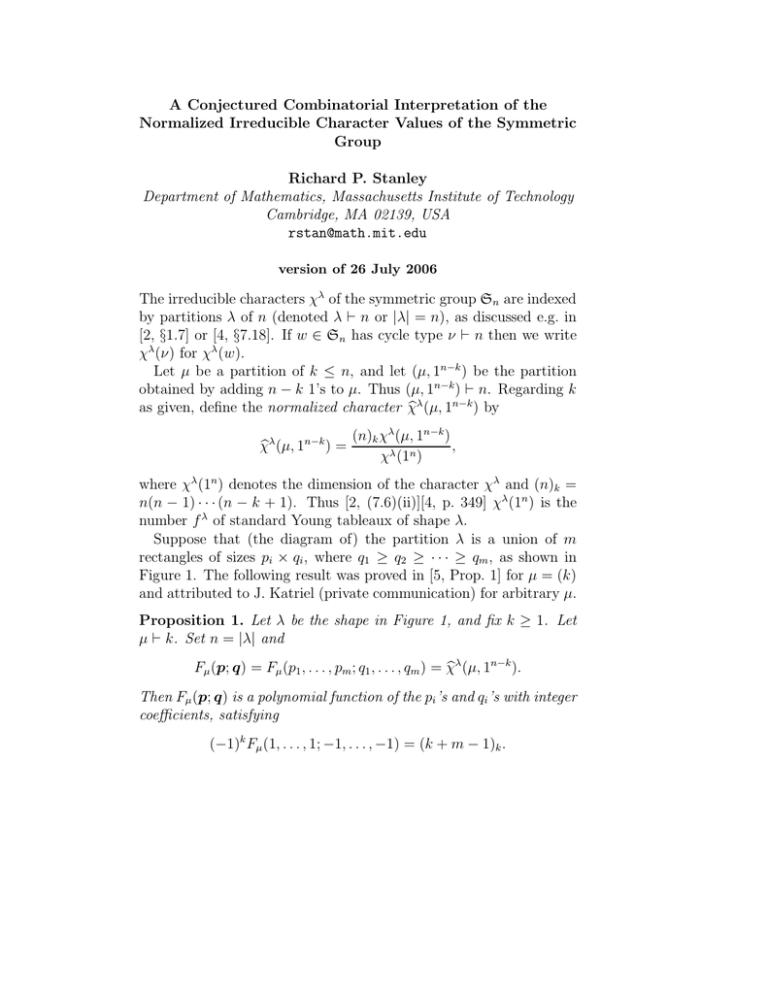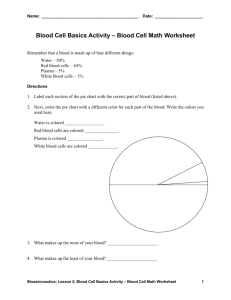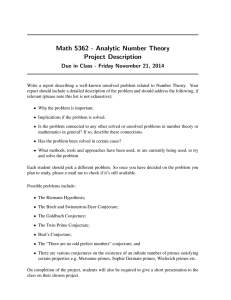A Conjectured Combinatorial Interpretation of the
advertisement

A Conjectured Combinatorial Interpretation of the
Normalized Irreducible Character Values of the Symmetric
Group
Richard P. Stanley
Department of Mathematics, Massachusetts Institute of Technology
Cambridge, MA 02139, USA
rstan@math.mit.edu
version of 26 July 2006
The irreducible characters χλ of the symmetric group Sn are indexed
by partitions λ of n (denoted λ ⊢ n or |λ| = n), as discussed e.g. in
[2, §1.7] or [4, §7.18]. If w ∈ Sn has cycle type ν ⊢ n then we write
χλ (ν) for χλ (w).
Let µ be a partition of k ≤ n, and let (µ, 1n−k ) be the partition
obtained by adding n − k 1’s to µ. Thus (µ, 1n−k ) ⊢ n. Regarding k
as given, define the normalized character χ
bλ (µ, 1n−k ) by
χ
bλ (µ, 1n−k ) =
(n)k χλ (µ, 1n−k )
,
χλ (1n )
where χλ (1n ) denotes the dimension of the character χλ and (n)k =
n(n − 1) · · · (n − k + 1). Thus [2, (7.6)(ii)][4, p. 349] χλ (1n ) is the
number f λ of standard Young tableaux of shape λ.
Suppose that (the diagram of) the partition λ is a union of m
rectangles of sizes pi × qi , where q1 ≥ q2 ≥ · · · ≥ qm , as shown in
Figure 1. The following result was proved in [5, Prop. 1] for µ = (k)
and attributed to J. Katriel (private communication) for arbitrary µ.
Proposition 1. Let λ be the shape in Figure 1, and fix k ≥ 1. Let
µ ⊢ k. Set n = |λ| and
Fµ (p; q) = Fµ (p1 , . . . , pm ; q1 , . . . , qm ) = χ
bλ (µ, 1n−k ).
Then Fµ (p; q) is a polynomial function of the pi ’s and qi ’s with integer
coefficients, satisfying
(−1)k Fµ (1, . . . , 1; −1, . . . , −1) = (k + m − 1)k .
q1
p
1
p
2
q2
.
.
.
pm
qm
Figure 1: A union of m rectangles
Note. When µ = (k), the partition with a single part k, we write
Fk for F(k) . A formula was given in [5, (9)] for Fk (p; q), viz.,
m
Y
(x)k
(x − (qi + pi + pi+1 + · · · + pm ))k
1
,
Fk (p; q) = − [x−1 ] m i=1
Y
k
(x − (qi + pi+1 + pi+2 + · · · + pm ))k
i=1
where [x−1 ]f (x) denotes the coefficient of x−1 in the expansion of
f (x) in descending powers of x (i.e., as a Taylor series at x = ∞).
It was conjectured in [5] that the coefficients of the polynomial
(−1)k Fµ (p; −q) are nonnegative, where −q = (−q1 , . . . , −qm ). This
conjecture was proved in [5] for the case m = 1, i.e., when λ is a
p × q rectangle, denoted λ = p × q. For w ∈ Sn let κ(w) denote
the number of cycles of w (in the disjoint cycle decomposition of w).
The main result of [5] was the following (stated slightly differently
but clearly equivalent).
2
Theorem 2. Let µ ⊢ k and fix a permutation wµ ∈ Sk of cycle type
µ. Then
X
Fµ (p; q) = (−1)k
pκ(u) (−q)κ(v) ,
uwµ =v
where the sum ranges over all k! pairs (u, v) ∈ Sk × Sk satisfying
uwµ = v.
(m)
To state our conjectured generalization of Theorem 2, let Sk
denote the set of permutations u ∈ Sk whose cycles are colored with
1, 2, . . . , m. More formally, if C(u) denotes the set of cycles of u, then
(m)
an element of Sk is a pair (u, ϕ), where u ∈ Sk and ϕ : C(u) → [m].
(We use the standard notation [m] = {1, 2, . . . , m}.) If α = (u, ϕ) ∈
(m)
(m)
Sk and v ∈ Sk , then define a “product” αv = (w, ψ) ∈ Sk as
follows. First let w = uv. Let τ = (a1 , a2 , . . . , aj ) be a cycle of w,
and let ρi be the cycle of u containing ai . Set
ψ(τ ) = max{ϕ(ρ1 ), . . . , ϕ(ρj )}.
For instance (multiplying permutations from left to right),
1
2
3
2
3
3
2
z }| { z}|{ z}|{ z}|{
z }| { z}|{ z}|{
(1, 2, 3)( 4, 5 )( 6, 7 )( 8 )·(1, 7)(2, 4, 8, 5)(3, 5) = (1, 4, 2, 6)( 3, 7 )( 5, 8 ).
Note that it an immediate consequence of the well-known formula
X
xκ(w) = x(x + 1) · · · (x + k − 1)
w∈Sk
(m)
that #Sk
= (k + m − 1)k .
Note. The product αv does not seem to have nice algebraic prop(m)
erties. In particular, it does not define an action of Sk on Sk , i.e.,
it is not necessarily true that (αu)v = α(uv). For instance (denoting
a cycle colored 1 by leaving it as it is, and a cycle colored 2 by an
overbar), we have
[(1)(2) · (1, 2)] · (1, 2) = (1)(2)
(1)(2) · [(1, 2) · (1, 2)] = (1)(2).
3
Q κ (α)
(m)
Given α = (u, ϕ) ∈ Sk , let pκ(α) = i pi i , where κi (α) denotes
the number of cycles of u colored i, and similarly q κ(β) , so (−q)κ(β) =
Q
κi (β)
We can now state our conjecture.
i (−qi )
Conjecture 3. Let λ be the partition of n given by Figure 1. Let
µ ⊢ k and fix a permutation wµ ∈ Sk of cycle type µ. Then
X
Fµ (p; q) = (−1)k
pκ(α) (−q)κ(β) ,
αwµ =β
(m)
(m)
where the sum ranges over all (k + m−1)k pairs (α, β) ∈ Sk ×Sk
satisfying αwµ = β.
Example 1. Let m = 2 and µ = (2), so wµ = (1, 2). There are six
(2)
pairs (α, β) ∈ Sn for which α(1, 2) = β, viz. (where as in the above
Note an unmarked cycle is colored 1 and a barred cycle 2),
α
β
pκ(α) q κ(β)
(1)(2) (1, 2)
p21 q1
(1)(2) (1, 2)
p1 p2 q2
(1)(2) (1, 2)
p1 p2 q2
(1)(2) (1, 2)
p22 q2
(1, 2) (1)(2)
p1 q12
(1, 2) (1)(2)
p2 q22 .
It follows (since the conjecture is true in this case) that
F2 (p1 , p2 ; q1 , q2 ) = −p21 q1 − 2p1 p2 q2 − p22 q2 + p1 q12 + p2 q22 .
We can reduce Conjecture 3 to the case p1 = · · · = pm = 1; i.e.,
λ = (q1 , , q2 , . . . , qm ). Let
X
pκ(α) q κ(β) ,
Gµ (p, q) =
αwµ =β
so that Conjecture 3 asserts that Fµ (p; q) = (−1)k Gµ (p, −q).
4
Proposition 4. We have
Gµ (p, q)|qi+1 =qi = Gµ (p1 , . . . , pi−1 , pi + pi+1 , pi+2 , . . . , pm ;
q1 , . . . , qi−1 , qi , qi+2 , . . . , qm ).
(1)
(m)
Proof. Let αwµ = β, where α, β ∈ Sk and µ ⊢ k. If τ is a cycle
of β colored i + 1 then change the color to i, giving a new colored
permutation β ′ . We can also get the pair (α, β ′) by changing all the
cycles in α colored i + 1 to i, producing a new colored permutation
α′ for which α′ wµ = β ′ , and then changing back the colors of the
recolored cycles of α to i + 1. Equation (1) is simply a restatement
of this result in terms of generating functions.
It is clear, on the other hand, that
Fµ (p, q)|qi+1 =qi = Fµ (p1 , . . . , pi−1 , pi + pi+1 , pi+2 , . . . , pm ;
q1 , . . . , qi−1 , qi , qi+2 , . . . , qm ),
because the parameters p1 , . . . , pm ; q1 , . . . , qi−1 , qi , qi , qi+2 , . . . , qm and
p1 , . . . , pi−1 , pi + pi+1 , pi+2 , . . . , pm ; q1 , . . . , qi−1 , qi , qi+2 , . . . , qm specify
the same shape λ. (Note that Proposition 1 requires only q1 ≥ q2 ≥
· · · ≥ qm , not q1 > q2 > · · · > qm .) Hence if Conjecture 3 is true
when p1 = · · · = pm = 1, then it is true in general by iteration of
equation (1).
Remarks. 1. Conjecture 3 has been proved by Amarpreet Rattan
[3] for the terms of highest degree of Fk , i.e., the terms of Fk (p; q) of
total degree k + 1.
2. Kerov’s character polynomials (e.g., [1]) are related to Fk (p; q)
and are also conjectured to have nonnegative (integral) coefficients.
Is there a combinatorial interpretation of the coefficients similar to
that of Conjecture 3?
5
References
[1] I. P. Goulden and A. Rattan, An explicit form for Kerov’s
character polynomials, Trans. Amer. Math. Soc., to appear;
math.CO/0505317.
[2] I. G. Macdonald, Symmetric Functions and Hall Polynomials,
second ed., Oxford University Press, Oxford, 1995.
[3] A. Rattan, in preparation.
[4] R. Stanley, Enumerative Combinatorics, vol. 2, Cambridge University Press, New York/Cambridge, 1999.
[5] R. Stanley, Irreducible symmetric group characters of rectangular shape, Sém. Lotharingien de Combinatoire (electronic) 50
(2003), B50d.
6





